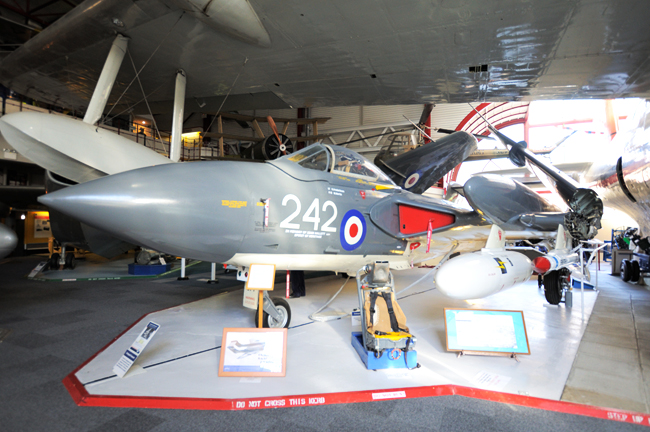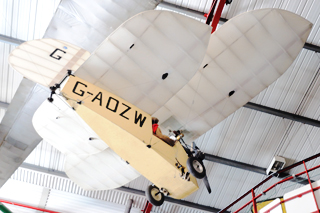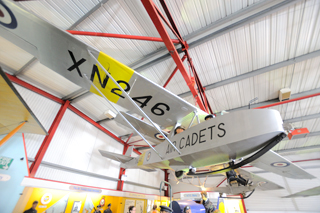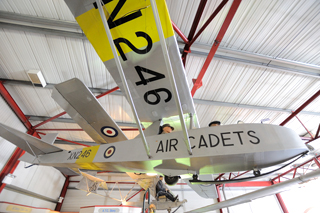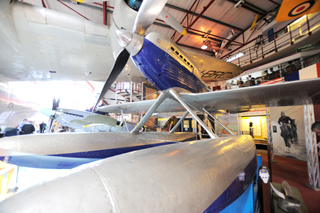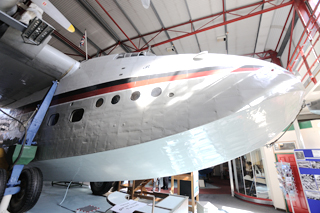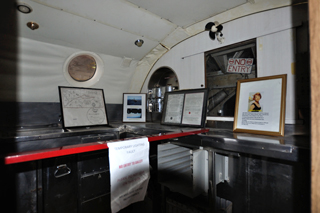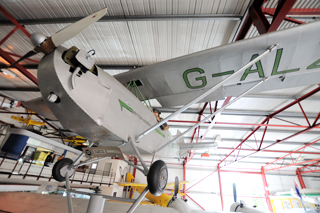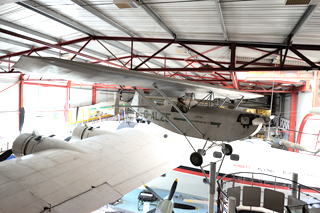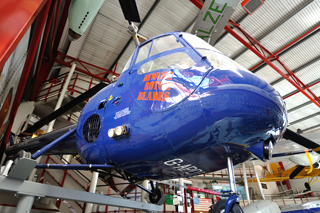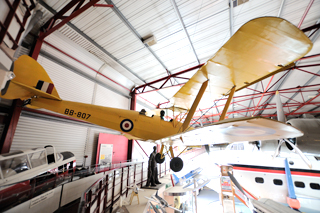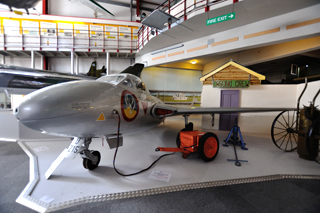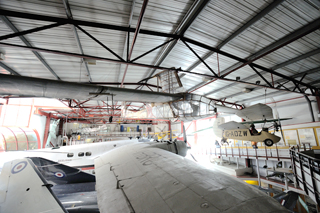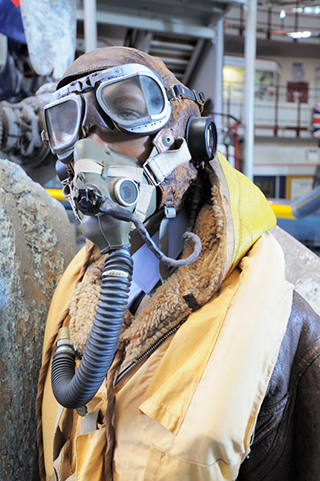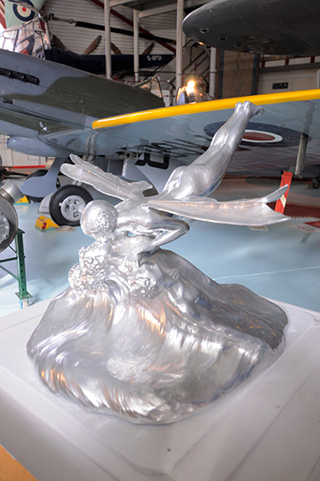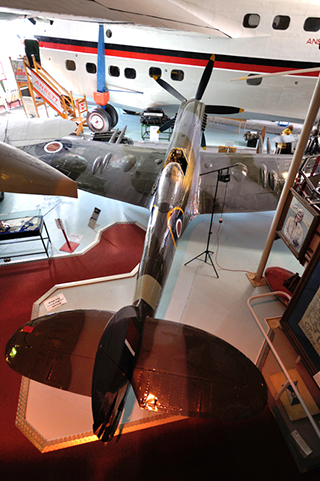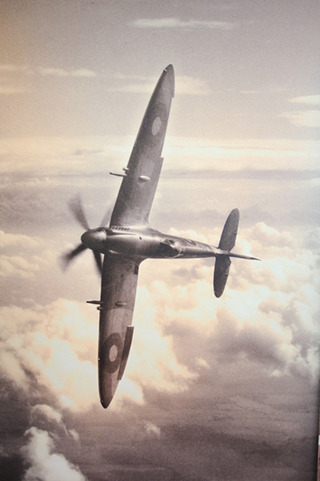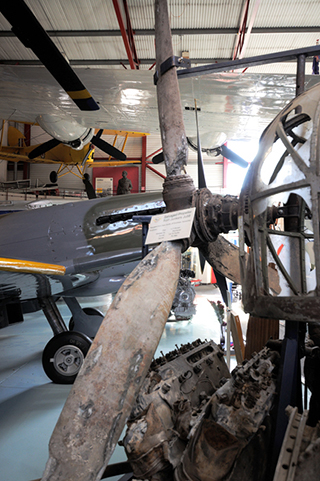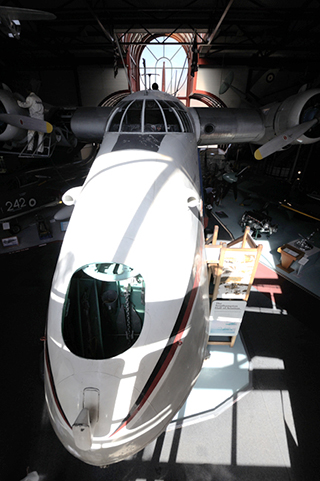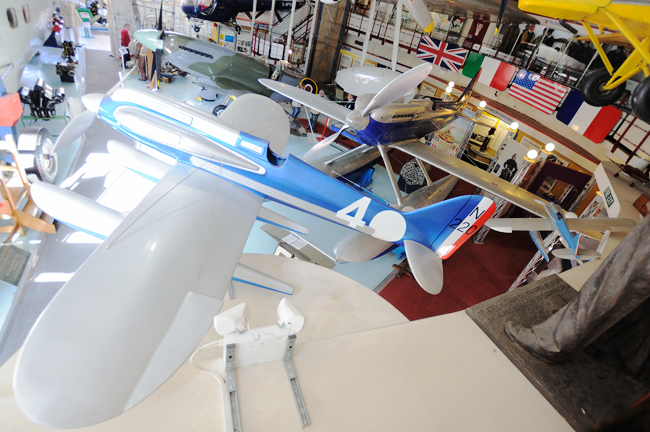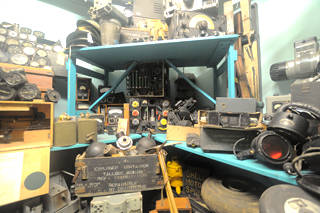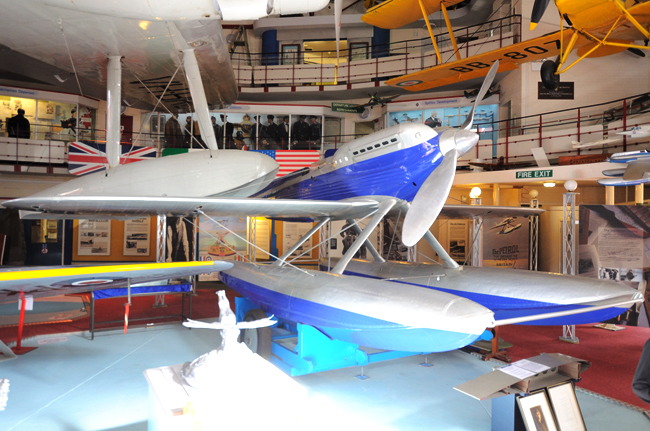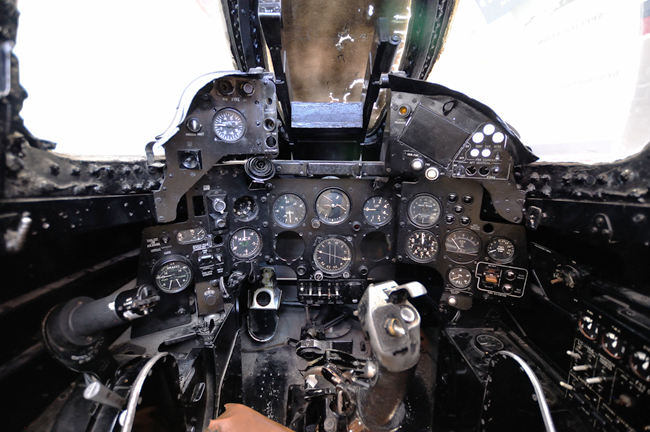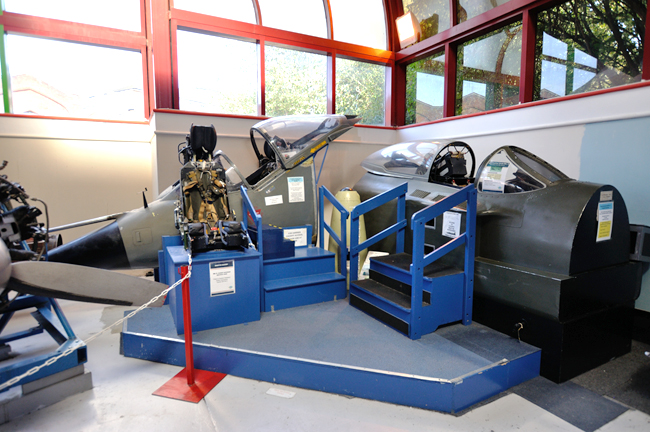This
eFLYER was developed in HTML for viewing with Microsoft Internet Explorer
while connected to the Internet: View
Online.
To ensure delivery to your inbox, please add eFLYER@barnstormers.com to
your address book or list of approved senders.
|
 |
ISSUE 424 - April 2016
Over 9,000 Total Ads Listed
1,000+ NEW Ads Per Week |
| Southampton's Solent Sky Museum |
By Kevin Moore, Contributing
Editor & Photographer
Watford, Ontario, Canada |
|
Arguably the most historically significant aircraft in the museum
is the sister ship of the Schneider Cup Tropy winner, the Supermarine S6A. |
| Tucked away in an unassuming building a few blocks from the River Itchen in Southampton, UK is the Solent Sky Museum. Originally the R. J. Mitchell Museum, it was often referred to as the "Spitfire Museum," and was originally located in an American built Nissan Hut that was used as Southampton's NAAFI during World War II. Now in a much larger facility, the museum houses at least 20 airframes as well as many artifacts of historic importance. |
|
| Probably the most revered aircraft in Britain is the Supermarine Spitfire. |
| Of course, the two feature aircraft that the museum is revolved around are both very historic in their own right, but the Spitfire is the most iconic of all British fighter aircraft and was, arguably, the most loved of all British aircraft from World War II. Often credited for winning the Battle of Britain, rightly or wrongly, the Spitfire and her pilots certainly made a difference in the skies over Britain during that fight for the island in 1940, and throughout the war. The museum's Spitfire was built under license by Vickers Supermarine and is a Mk 24. |
|
A unique aircraft is the jet flying boat, the SRA 1 Sanders-Roe,
the sole survivor of only 3 that were built. |
| Inside the museum you'll find a vast array of different wartime artifacts as well as many items that offer insight into assorted times in aviation history in the UK. One of the first things you'll see, that really catches the eye, is the SRA 1 Saunders Roe flying boat, a jet engine powered aircraft that first flew in 1947. Though the aircraft had a maximum speed of 500mph, it never got past the prototype stage and only 3 of the aircraft were ever produced with the museum's aircraft being the sole survivor. |
|
The futuristic looking de Havilland Sea Vixen sits beneath
the big wing of the Sandringham flying boat. |
| The next aircraft almost looks like something out of the future, the de Havilland Sea Vixen FAW2. The Sea Vixen is a 2-seat, all-weather carrier attack aircraft that first went into service flying from British Naval carriers, HMS Victorious and Centaur, in 1958. Though the Sea Vixen was retired from front line service in 1972, a few aircraft continued to serve with the Royal Aircraft Establishment until 1991. |
|
It's not very often you see an aeroplane with more than 2 wings
but the aptly named Quadra Plane Scout comes with 4! |
| One of the more unusual looking aeroplanes is the Wight Quadra Plane Scout (replica), a 4-winged aircraft built by J. Samual White & Co. of Cowes for the Royal Navy in 1916. Originally built for the Royal Navy, only three of the unusual aircraft were completed and they were never put into production. This replica was started by the Wessex Aviation Society and completed by a combination of museum staff and 424 Squadron ATC. |
|
|
| The rather oddly looking and appropriately named Flying Flea. |
| As you walk around you need to make sure you look up as well because there are an assortment of aircraft hanging from the museum's roof such as Mignet Pou-du-Ciel HM.14 Flying Flea. This odd looking aircraft was designed by Frenchman Henri Mignet and first flew in 1933. It had a wingspan of just under 20' and a length of 11.5' with a speed range of 25mph - 62mph . Many of these aircraft were built in France, the UK, the USA as well as a few other countries and several survive today in museums around the world. |
|
|
The Slingsby T-31B Cadet glider was the mainstay of the
Air Training Corps glider training program in the UK for more than 30 years. |
| Another aircraft suspended in the main hall of the museum is the Slingsby T31B Cadet TX Mk3, the basic training glider that was used by the ATC gliding schools in the UK for more than 35 years. 126 of these aircraft were delivered to the RAF for the ATC gliding program from 1951 to 1959 and served until 1986. The Cadet has a maximum speed of 80mph and a stall speed of 38mph. |
|
|
| One of the most visually stunning aircraft of the 1930s, brought to you from the mind of famed Spitfire designer, R. J. Mitchell, is the beautiful Supermarine S6A. |
| Probably the most historic of aircraft at the museum, and the last of the great racing seaplanes, is the Supermarine S6A. Supermarine won the Schneider Trophy outright with the S6A's sister ship, S6B in 1931, by winning the race three consecutive years by the same country. The museum's S6A was used as a reserve aircraft for the 1931 race after having suffered an emergency landing on the water behind an ocean liner which resulted in the aircraft overturning. She was salvaged and repaired though never flew again and was given to the city of Southampton by Vickers Supermarine, then being displayed on the Royal Pier for many years before being restored by the British Hovercraft Corporation. The S6A was on display at the R.J. Mitchell Memorial Museum until 1984 when she was moved to the current Solent Sky Museum. |
|
|
| The Short Sandringham is the largest aircraft in the museum's fleet. |
| The largest aircraft in the museum's inventory is the Short Sandringham flying boat named "Beachcomber" which was built by the Short Brothers with this example having been built in 1943 as a Short Sunderland Mk 1II. The aircraft faced several conversions from a midget sub carrier to a Sunderland Mk 5 and eventually into a Sandringham Mk IV Tasman class which seated 30 passengers. The history of the aircraft includes a period of flying on routes in New Zealand, Australia, the Virgin Islands, the Caribbean and eventually ended up in Puerto Rico before being purchased by the Science Museum in 1982, ending up in the Southampton Hall of Aviation which became the Solent Sky Museum. |
|
|
Looking up at the bulky nose of the Sandringham, left.
Part of the galley inside the Sandringham, right. |
| The Sandringham had a crew of 5 and, in its final configuration, could carry 44 passengers. As a Sunderland, she would carry a crew of 9 to 11 which included the pilot, co-pilot, flight engineer, navigator, radio operator and 3 to as many as 5 gunners. Despite her size and bulkiness, she could cruise at 180mph with a maximum speed of over 200mph and a range of 3,000 miles with a service ceiling of 16,000 feet. The aircraft also had quite an amazing endurance, capable of remaining in the air for 15 - 20 hours at a time. |
|
|
| Aircraft manufacturer, Brittan Norman, developed the BN.1 as their first aircraft. |
| The very first aircraft built by Brittan Norman, mounted along the mezzanine over the main hall, is the BN.1. The aircraft was built on the Isle of Wight in a disused cinema and first flew at Bembridge Airport in 1951. The aircraft had a maximum speed of 120mph and was originally built with a 2 cylinder, 40hp Aeronca JAP air-cooled engine. After a crash during an early flight, modifications were made to the aircraft, including replacing the Aeronca engine with a Lycoming O-145 horizontally opposed engine, as well as adding ancillary fins to the tail to improve directional stability and inset ailerons. The aircraft only flew for roughly 2 years before it was withdrawn from service. It was restored to flying condition post World War II but now resides in the museum. |
|
|
The Folland Gnat was the first aircraft flown by the
famed RAF Red Arrows aerobatic display team. |
| Another jet aircraft at the museum is the Folland Gnat F1 built by Folland Aircraft Ltd in Hamble, UK with the prototype, known as the Midge, first flying in 1954 at the renowned Farnborough Airshow. It was redesigned after a different, more powerful engine was made available and flew, as the Gnat, in 1956. Though a fighter version was built under license in India, the only aircraft flown by the RAF were known as a T1, a two-seat version trainer. It was the first aircraft used by the RAF Red Arrows aerobatic display team which was formed from the RAF Yellow Jackets. The museum's aircraft was one of six of its type ordered by the British Ministry of Supply and flew at Farnborough Airshow the year it was built, 1957. It was used for engine development, then as a ground instructional airframe and finally used as a recruitment aircraft after having been painted in Red Arrows colours. She was eventually returned to the former Folland factory for restoration to her original markings and livery and, upon completion, was displayed at the museum. |
|
|
| The Skeeter is an early design, 2-seat helicopter, from Saunders Roe. |
| The bright blue Cierva/Saunders Roe Skeeter Helicopter sits on a stand at one end of the museum. It was first designed in 1947 by the Cierva Autogyro Company as a small, 2 seat helicopter that could be used in both military and/or civilian roles and first flew in 1948 with an under-powered experimental Jameson FF-1 engine. That was replaced in the a newer version of the aircraft with the de Havilland Gipsy Major engine with which later marks of the aircraft were built and flown after Saunders Roe took over the helicopter programme. The museum's version, a Saunders-Roe Skeeter Mk 8, was one of only 3 civilian versions built and the only one that flew. It served as a development aircraft by the company until 1964. In 1998 it was restored to flying condition, making it a Mk 12 version, but concern over possible corrosion issues in the main rotor grounded the aircraft and it was donated to the museum. |
|
|
The much loved de Havilland DH82 Tiger Moth,
mainstay of RAF flight training for more than 20 years. |
| Another aircraft in the museum inventory is the de Havilland DH82 Tiger Moth, designed by Geoffrey de Havilland, and was based on the DH60 Gypsy Moth with the prototype first flying on October 26th, 1931. More than 7000 were built in the UK, with over 4000 flying with the RAF, but another 2923 were built in Canada, Australia, New Zealand, Sweden, Portugal and Norway. Many of these beautiful biplanes exist today in countries around the world. |
|
|
The DH115 de Havilland Vampire trainer, left, and the human powered aircraft,
built by the University of Southampton, the SUMPACK, right. |
| Other aircraft that can be seen in the museum include the de Havilland DH115 Vampire trainer, the Avro 504J, the Grasshopper glider, Sumpack and the Airwave Hang Glider. Though the museum aircraft are relatively numerous and the building itself is not overly large, they have done a super job of displaying all aircraft as well as their various artifacts and exhibits. |
|
|
| The image of a World War II fighter pilot, left, and a replica of the top portion of the Schneider Trophy, right, forever retained by Britain and won by the Supermarine S6B. |
| Some of those artifacts and exhibits include various engines, manequins with uniforms of the day, vintage model aircraft, propellers, a link trainer and a cockpit of a former RAF Hawker Harrier as well as a Hawker Hunter that you're able to sit in as well as other assorted items of interest. You can also browse the small gift shop near the entrance of the museum. |
|
|
The sleek lines of the Spitfire are evident from above, left.
A large vintage photo of a Spitfire in the skies above Britain, right. |
| The Solent Sky Museum is a wonderful place to spend a day browsing around and learning more about the history of various stages of aviation in the UK. From the Spitfire and the Supermarine S6A to the vintage gliders and into the jet age, there's something for all ages and all likes. The museum needs your support to keep the doors stay open, restore aircraft and artifacts and even with their displays and that support is needed in both funds and volunteers. Visit the Solent Sky Museum for a look back at England's south coast aviation and wartime history of the Southampton area. |
|
|
| The Mid-Upper Gun Turret, built by Armstrong Whitworth, from an Avro Anson Mk IV, left. A propeller that was salvaged from a downed Ju88 of the Luftwaffe, found off the Southsea, Hampshire coast, right. |
| For more information about the museum and how to get to it, visit their website: solentskymuseum.org |
|
|
| Looking down at the nose section and long the length of the fuselage of the Sandringham, left, and inside the passenger compartment, right. |
|
| In the foreground is a large scale model of the Supermarine S6B, the museum's S6A, centre, and Spitfire in the background, as well as other assorted aircraft and artifacts. |
|
|
A lovely set of beautifully built models of flying boats, left.
An assortment of various aircraft instruments on display, right. |
|
The Supermarine S6A, the sister ship of the final winner
of the Schneider Trophy, the Supermarine S6B. |
|
You may get the opportunity to sit inside the cockpit section of the
Hawker Harrier
and spend time reviewing all the instrumentation in front of you. |
|
| Some of the many fabulous vintage models on display. |
|
| The cockpit sections of the Hawker Harrier, left, and the Hawker Hunter, right. |
|
One of several engines on display but probably the most well known of all engines from British built World War II aircraft, the Rolls Royce Merlin X, most famous for powering early versions of the Supermarine Spitfire as well as the Hawker Hurricane, Avro Lancaster, de Havilland Mosquito and many more. |
|
The Supermarine S6 sitting on its trailer near the water in Southampton
(Archived photo courtesty the Solent Sky Museum). |
|
The Supermarine S6 in a night shot being prepared for a race the next day
(Archived photo courtesty the Solent Sky Museum). |
|
| A final look, from above, at the Supermarine S6A. |
|
| |
|







